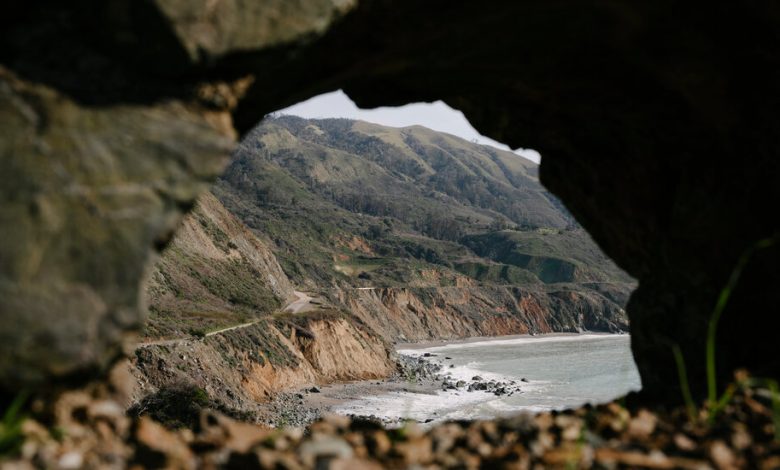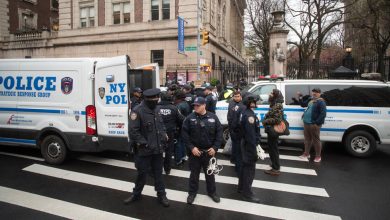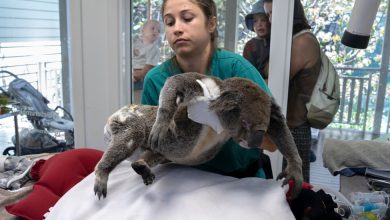In Big Sur, Living With Nature’s Beauty but Trapped by Its Fury

ACROSS THE COUNTRY

In Big Sur, Living With Nature’s Beauty but Trapped by Its Fury
The succession of storms last month that left some residents in that treasured region cut off from the rest of California is another reminder of the perils and adventure of Central Coast life.
WHY WE’RE HERE
We’re exploring how America defines itself one place at a time. On one stretch of California’s rugged Central Coast, being cut off from the state for weeks or months is a way of life for this tight-knit community.
By Victoria Kim
Photographs by Ian C. Bates
Feb. 4, 2023
BIG SUR, Calif. — Under cover of darkness, John Handy edged his Chevy Silverado as far south as he was allowed, contemplating escape.
To his right, the Pacific lapped at the jagged coastline. To his left, the steep hillside loomed precariously over Highway 1, threatening to cascade down once more after having already buried much of the road during relentless winter storms that pounded California.
He listened for trickling water, for tumbling rocks big and small, for errant rumbles — signs that the earth was once again about to mock the hubris of those who once saw fit to carve a road into the Santa Lucia Mountains where they plunge directly into the ocean.
For weeks since the beginning of the year, a 20-mile rugged stretch of Big Sur on the California coast that Mr. Handy and a couple hundred of his neighbors call home has been turned into an island after landslides blocked Highway 1 to the north and south.
The locals have grown accustomed to recurring isolation over the years, but they have yet to solve for every predicament. A man in his 70s fell in his home and could not be reached by an ambulance. A third-grader could not get to school. And a couple of the newly captive islanders ran out of blood pressure medications and resorted to eating as much garlic, a natural alternative, as they could stomach.
“It feels like we’re prisoners really, for weeks with no way out,” said Mr. Handy, 64, who has lived here with his family since 2007.
Big Sur teeters at the edge of the continent as a loosely defined, 70-mile stretch about halfway between San Francisco and Los Angeles. Dramatic cliffs, coastal redwoods and an unfettered horizon along the Pacific Ocean conjure a majestic experience that the writer Henry Miller once described as “almost painful to behold.”
“It seeks to remain unspoiled, uninhabited by man,” Miller wrote in his 1957 memoir on living in Big Sur, by which time he was already bemoaning the increasing number of visitors. “It was always a wild, rocky coast, desolate and forbidding to the man of the pavements.”
Big Sur has inspired poets and artists, lured homesteaders, hermits and hippies, and drawn millions of tourists each year. About 2,000 hardy people live here year-round. It is also perhaps the best embodiment of the California bargain — that living with awe-inspiring natural beauty can mean accepting the potential perils of nature’s destructive forces.
It is an exacting price those living in Big Sur have grown familiar with, paid for in repeat evacuations during wildfires and mudslides, and periods of isolation ever since Highway 1 was completed in 1937 along the coast.
Driving south from San Francisco in mid-January after three weeks of storms, I had a hard time keeping my eyes on the road and avoiding being entranced by the vast ocean views. Sections of the asphalt were rust-colored from recently cleared landslides, debris from which sat in roadside mounds like oversize ant hills.
I could reach the northern parts of Big Sur, including the area that most resembles a town, with a lodge, a bakery and post office. But I was turned back just past the Esalen Institute, a New Age retreat, where the road was closed, trapping residents to the south. Anyone who lived further, including Mr. Handy, I had to settle with interviewing over the phone.
The landslide spots are so infamous that they have names. To the north of the area currently isolated, there is Paul’s Slide and Mill Creek Slide. To the south, Polar Star Slide.
They result from geological forces that have conspired for millions of years before humans ever set foot on this coast. The hillsides consist of a mélange of sheared and metamorphosed sedimentary and igneous rocks, crisscrossed with faults that allow water to seep beneath and destabilize the slopes.
Having been locked in time and time again, people here are prepared for prolonged removal from the world. They keep their pantries stocked with rice, beans and powdered milk, fill their generators with propane ahead of winter, and regularly check on their neighbors. Many keep second cars — often a used clunker — that they can park on the other side of a road closure and reach by foot.
Shelley Newell, 72, arrived in 1967 on her own as a teenager fleeing her strict hometown of Pacific Grove some 30 miles north, where alcohol sales were banned at the time and she was getting into trouble for cursing.
The lessons from her first winters in Big Sur have stuck. On a recent Costco run, she bought eight pounds of coffee. The first time she remembers being cut off, around 1970, she quickly ran through a one pound bag of rice and had to subsist for a month on abalone picked along the coast and venison from roadkill, she said. To this day, she cannot stand abalone because of the memory.
Now, she has some 50 pounds of rice, 20 pounds of beans and a cupboard full of canned tuna that she guesses could last her and her partner, David, for at least year.
“Big Sur’s never been conquered, the land is still pretty rugged, which appeals to a certain kind of people,” Ms. Newell said.
Magnus Toren, the longtime director of the Henry Miller Library, said the demands that Big Sur makes of its residents are at the core of its appeal.
“There is sort of a vulnerability to the landscape here,” he said. “The fires and the landslides, and the crashing waves of the Pacific Ocean when it runs wild, that all conspires to make you aware of nature.”
In decades prior, road crews allowed residents to make their own decisions about when to come and go during landslides, locals say.
But in recent years, officials have been stricter about enforcing road closures with locked gates or heavy equipment parked across partially cleared, passable lanes. Residents blame smartphone-wielding tourists who have tried to take videos of themselves navigating Big Sur’s most hazardous conditions.
Officials at Caltrans, the California Department of Transportation say the dangers are not always readily apparent, no matter how familiar anyone may be with the terrain. Take Paul’s Slide, which in early January shoved 8,000-pound concrete barriers that had been staked into the pavement halfway across the highway.
“That’s a lot of force,” said Kevin Drabinski, a spokesman for Caltrans. “It’s this conversation that’s been going on for centuries between the mountains and the Pacific Ocean, and we placed a road right there.”
State officials have organized occasional convoys to let residents caravan through the northern closures to make supply runs. About four weeks into the latest confinement, officials also sent a helicopter to drop a load of groceries, water, medication and mail.
Jasmine Horan, 42, grew up in Big Sur and is now a single mother living with her aging parents. She remembers being able to walk across slide areas to get to school when she was young and being allowed through closures with a local ID, she said.
But this year, she has had to home-school her 9-year-old daughter and closely monitor her father’s blood pressure as his medication ran low, she said.
In mid-January, a neighbor found a resident in his 70s collapsed in his home. An ambulance could come only as far as the southern closure.
Four members of the local volunteer fire brigade considered hiking across Polar Star Slide with the man on a stretcher, but heavy rain rendered that option unsafe, recalled Mike Handy, 31, the son of John Handy and a volunteer firefighter.
Hours later, after nightfall, with all other options exhausted, the man was airlifted by a National Guard helicopter to a hospital in San Luis Obispo, he said.
It was a few days later, once the rains had stopped, that the older Mr. Handy, a toy designer who now runs the Treebones Resort, mulled over his own risks of hiking across the slide on foot in defiance of sternly worded orders from local and state officials.
His granddaughter, Cici, was turning 2 soon, and he wanted to again see his newborn grandson, Lev. They lived south of Polar Star Slide in Morro Bay.
The danger seemed contained, and he thought it would be safe for him to walk across the 100 yards or so to the outside world.
But he ultimately decided against it. Instead, he later managed to talk road workers into letting him through a closure up north, he said — and he drove the long way around, two hours north, then two hours south on inland roads to make it to Morro Bay. He dressed as a giraffe and his wife wore a kangaroo costume for the animal-themed birthday party.
“It was her special day,” he said. “You can’t miss that.”



